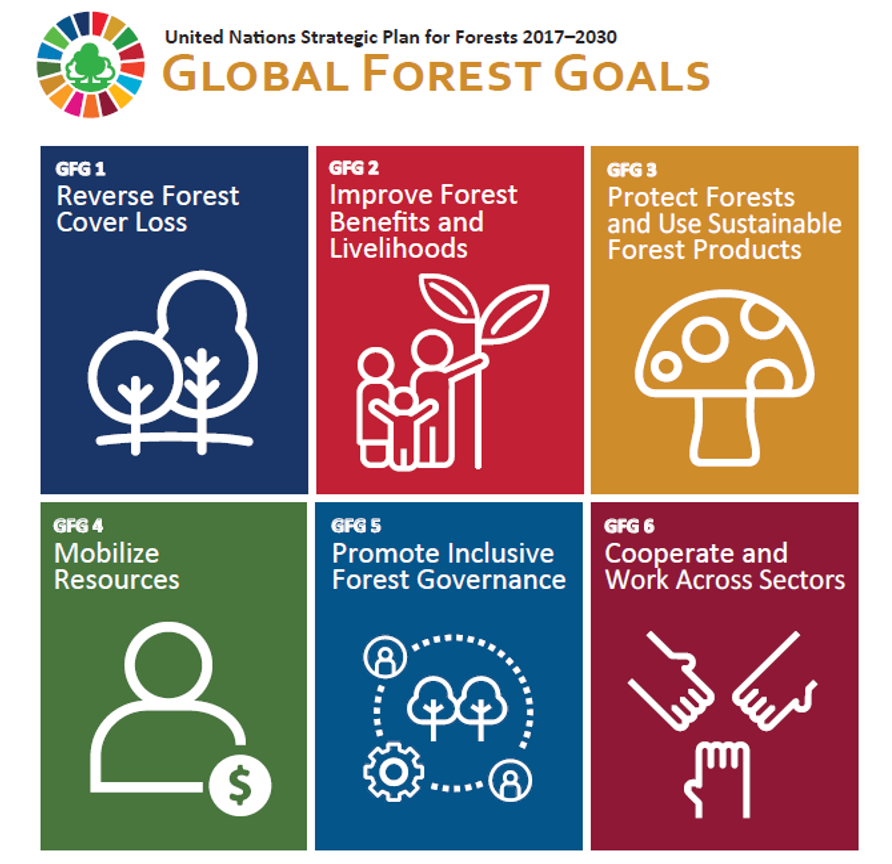Biodiversity & Environment
The Global Forest Goals Report 2021: UN Report
- 30 Apr 2021
- 7 min read
Why in News
According to the United Nations’ Global Forest Goals Report 2021, Covid-19 pandemic has aggravated the challenges faced by countries in managing their forests.
- The Report has been prepared by the Department of Economic and Social Affairs of the United Nations. It provides an initial overview of progress of Goals and targets contained within the United Nations Strategic Plan for Forests 2030.
Key Points
- Findings of the Report:
- Covid-19 leading to Systemic Vulnerabilities and Inequalities:
- More than just a health crisis, Covid-19 is driving losses of lives and livelihoods, extreme poverty, inequality, and food insecurity, and it has put the ‘Future We Want’ further out of reach.
- Impact of Covid-19 on Global Output:
- It is estimated that world gross product fell by an estimated 4.3% in 2020. It is the sharpest contraction of global output since the Great Depression.
- Covid-19 is Threatening the Lifeline that Forests Provide:
- An estimated 1.6 billion people, or 25% of the global population, rely on forests for their subsistence needs, livelihoods, employment, and income.
- Of the extreme poor in rural areas, 40% live in forest and savannah areas, and approximately 20% of the global population, especially women, children, landless farmers, and other vulnerable segments of society look to forests to meet their food and income needs.
- Impact of Covid-19 on Forest Dependent Population:
- On the economic front, forest-dependent populations have faced job loss, reduced income, diminished access to markets and information, and for many women and youth, a contraction in seasonal employment.
- Socially, many of these populations are already marginalized and vulnerable groups, such as indigenous peoples, least able to access critical socio-economic safety nets.
- Many forest dependent populations, especially those in remote or hard to reach places, have faced difficulties accessing healthcare or find that government assistance programmes and basic services are disrupted.
- Increased Pressure on Forest:
- Pandemic driven health and socio-economic outcomes have increased pressure on forests.
- To ease their growing vulnerability, many indigenous peoples and local communities, as well as returning migrants and urban workers, have retreated deeper into the woods to seek food, fuel, shelter, and protection from the risks of Covid-19.
- Biodiversity Crisis:
- Among its many findings, the ‘Global Assessment Report on Biodiversity and Ecosystem Services’ of the Intergovernmental Science-Policy Platform on Biodiversity and Ecosystem Services (IPBES) highlighted that one million species were at risk of extinction and that 100 million hectares of tropical forest were lost from 1980 to 2000.
- At the same time, climate change is jeopardizing the resilience of forest ecosystems and their ability to support ecosystem services worldwide.
- Though forests offer nature-based solutions to overcome these concurrent global challenges, they have also never been more at risk.
- Covid-19 leading to Systemic Vulnerabilities and Inequalities:
- Suggestions:
- The resilient recovery from the Covid-19 pandemic along with responses to the climate and biodiversity crises must be rooted in the world’s forests.
- Forests and forest-dependent people are both a casualty and an important part of the solution.
- Sustainably resourced and managed forests can bolster employment, disaster risk reduction, food security and social safety nets, for starters.
- Forest can also protect biodiversity and advance both climate mitigation and adaptation.
- With regard to global health, safeguarding and restoring forests are among the environmental actions that can reduce the risk of future zoonotic disease outbreaks.
- The report called for a future course of action that included greater sustainability and a greener and more inclusive economy to tackle the threats of Covid-19, climate change and the biodiversity crisis faced by forests.
- The resilient recovery from the Covid-19 pandemic along with responses to the climate and biodiversity crises must be rooted in the world’s forests.
Status of World Forest
- Total Forest Area: According to the Global Forest Resources Assessment 2020 (FRA 2020) report, the world’s total forest area is 4.06 billion hectares (bha), which is 31% of the total land area. This area is equivalent to 0.52 hectares per person.
- Top Countries in Forest Cover—the Russian Federation, Brazil, Canada, the United States of America and China constituted more than 54% of the world’s forests.
Forest in India
- According to the India State of Forest Report, 2019, the Total Forest and Tree cover is 24.56% of the geographical area of the country.
- Forest Cover (Area-wise): Madhya Pradesh> Arunachal Pradesh> Chhattisgarh> Odisha> Maharashtra.
- National Forest Policy of India, 1988 envisages a goal of achieving 33% of the geographical area of the country under forest and tree cover.
United Nations Strategic Plan for Forests 2017–2030
- The United Nations Strategic Plan for Forests 2017-2030 was created with a mission to promote sustainable forest management and enhance the contribution of forests and trees to the 2030 Agenda for Sustainable Development.
- The agreement on the first-ever UN Strategic Plan for Forests was forged at a special session of the UN Forum on Forests held in January 2017 and provides an ambitious vision for global forests in 2030.
- Goals and Targets: It features a set of six Global Forest Goals and 26 associated targets to be reached by 2030, which are voluntary and universal.
- It includes a target to increase forest area by 3% worldwide by 2030, signifying an increase of 120 million hectares, an area over twice the size of France.
- It builds on the vision of the 2030 Agenda and recognizes that real change requires decisive, collective action, within and beyond the UN System.





